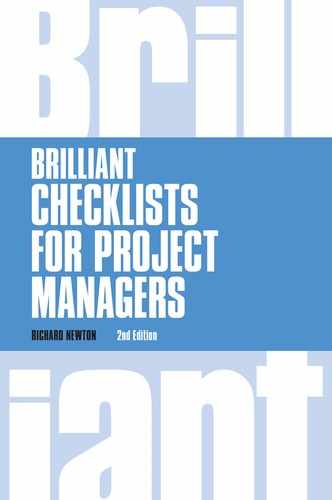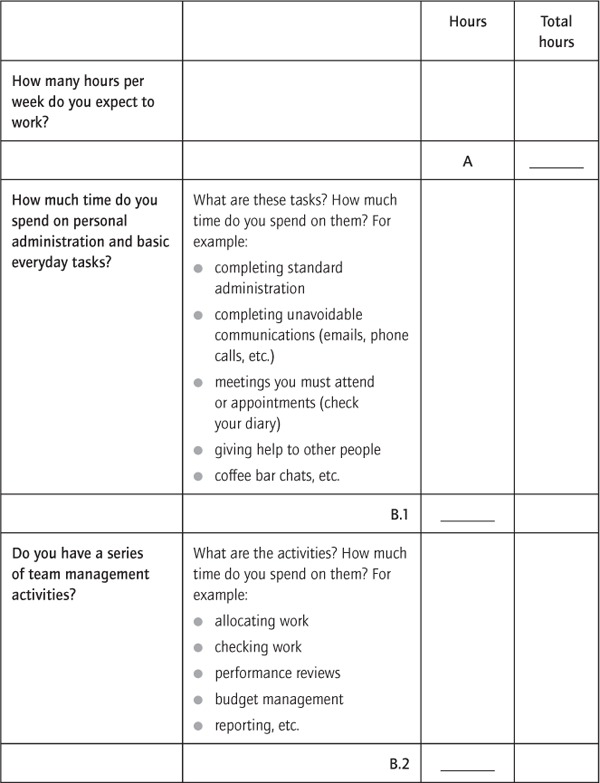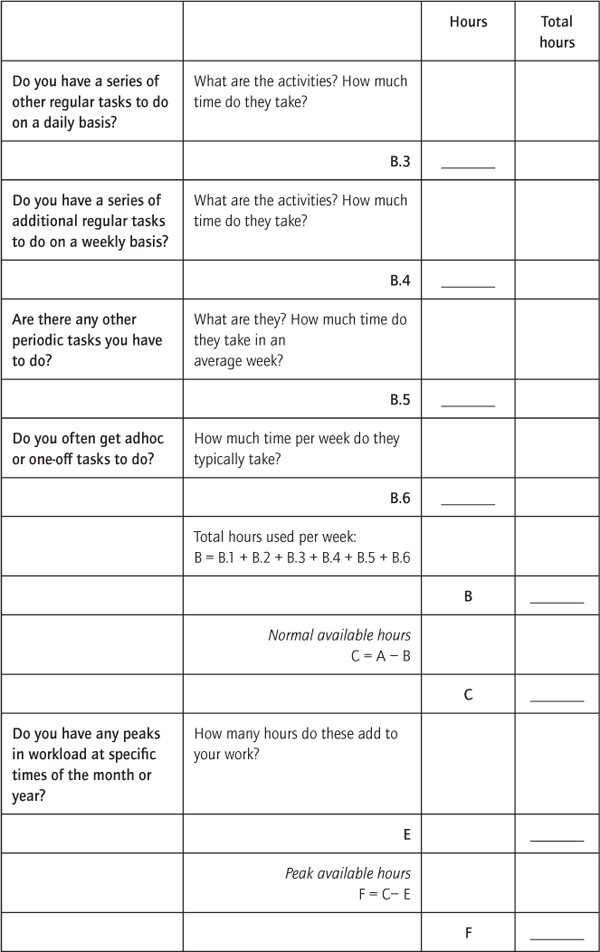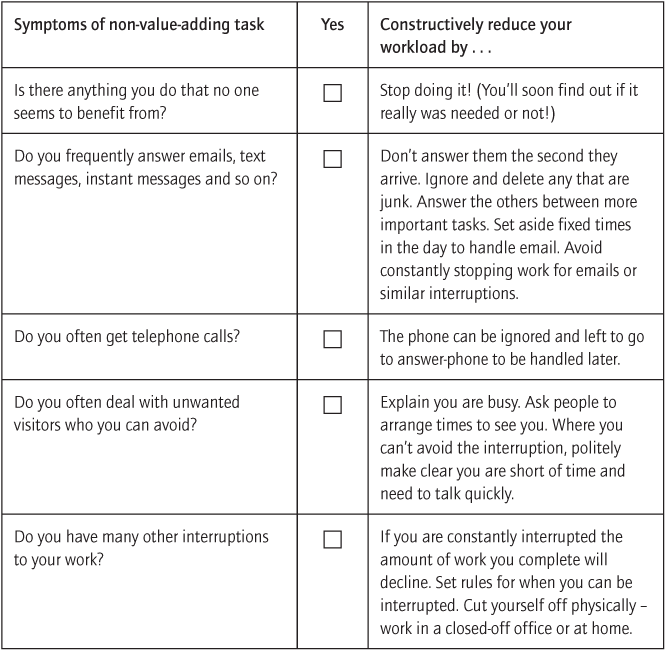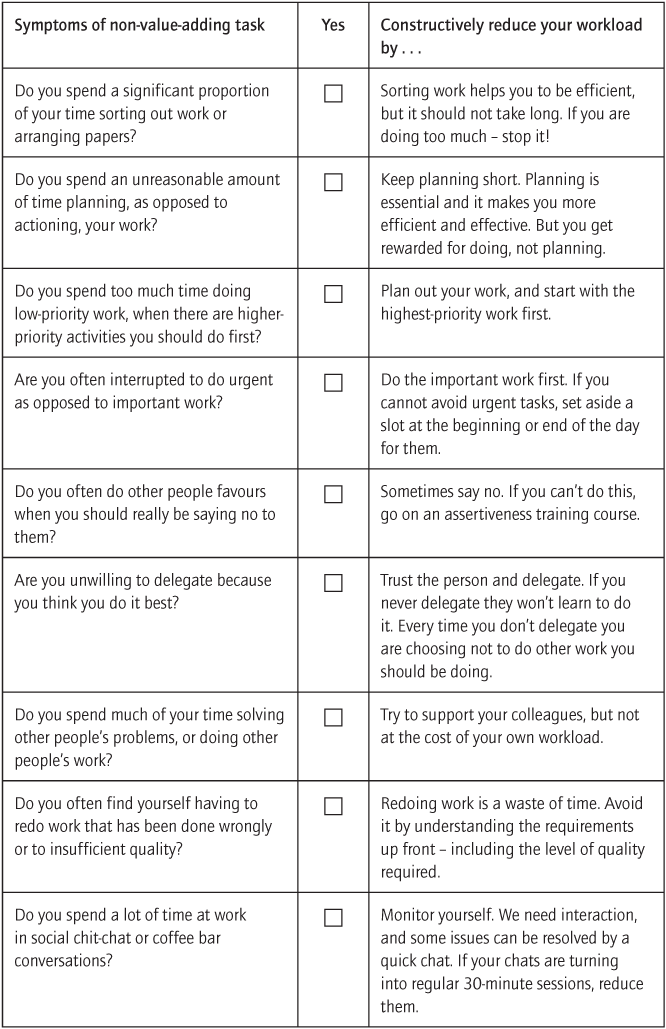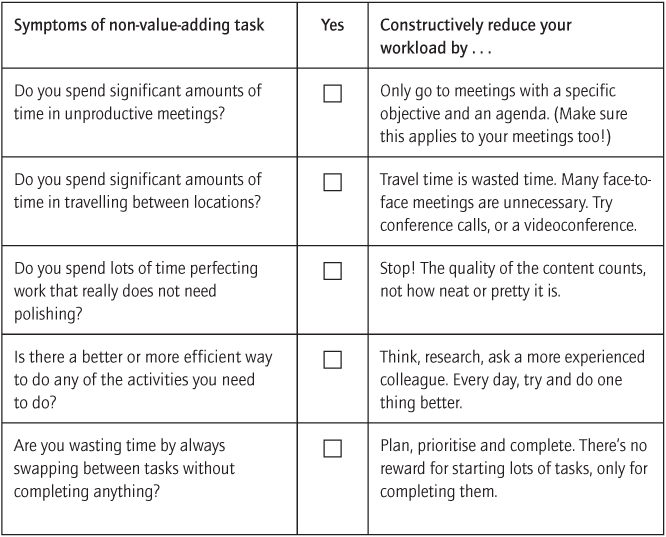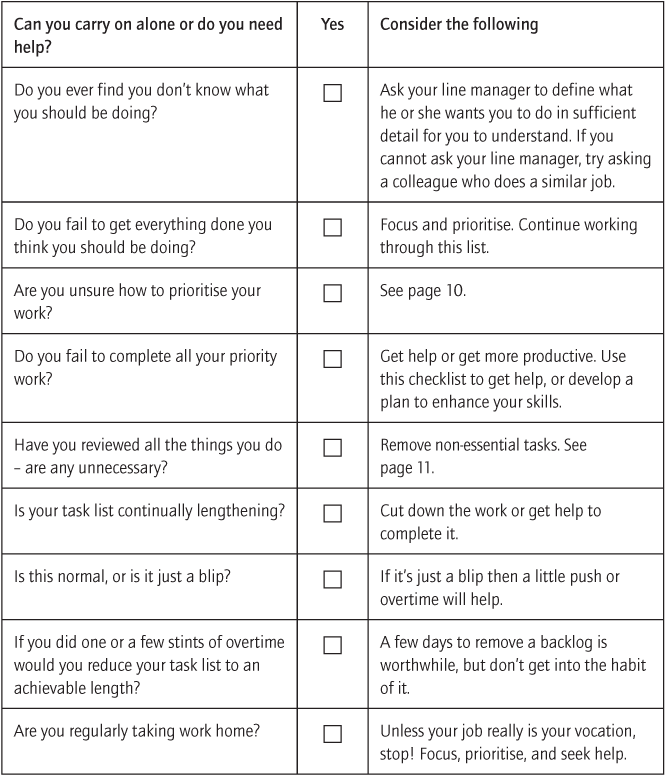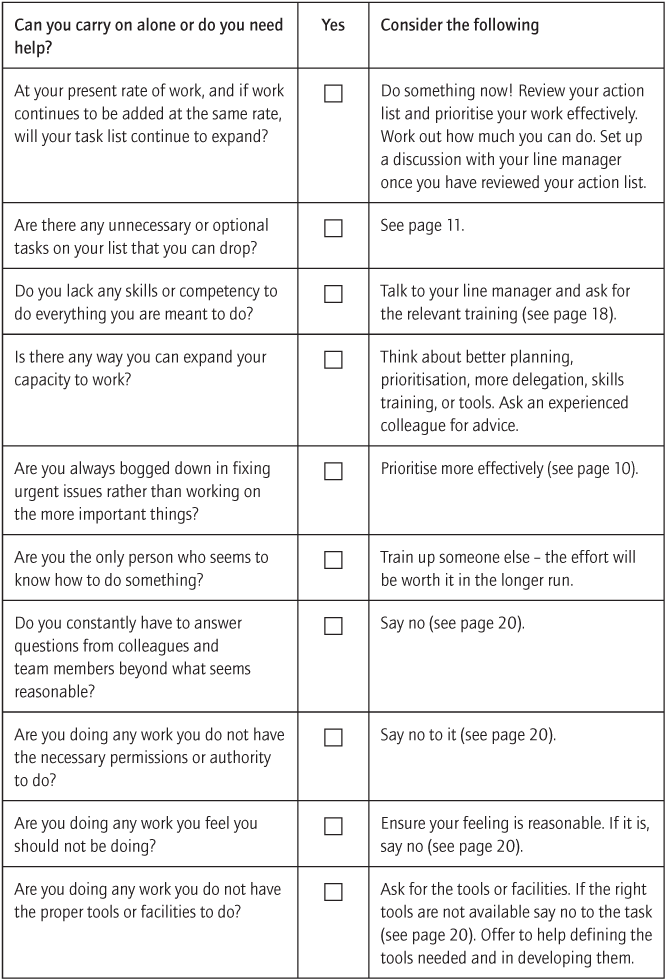This chapter helps you to control your workload better. It assumes you are a member of a team with a line manager, and want some advice on making your own time more productive.
Understanding your workload
To manage your time you must understand your workload. Projects will always be a struggle if you cannot plan your own time. The following table provides a tool to plan your time better. It is a tool to be used quickly. Don’t over-analyse the questions! Rough estimates will do.
The important numbers are C and F:
- C is the time you have for additional work including projects.
- If C is negative then you need to become more efficient or reduce the amount you are doing. The checklists on pages 8–20 will help.
- The same applies to F for peak periods of the year. If F is a positive number you have time for more work, including projects. F will probably be negative. This is not necessarily a problem, depending on how long and frequent your peaks are.
Writing an effective action list to plan your work
High productivity starts with self-management. Often, you will have more to do than can be done in the available time. This means making choices about what you do and how long you spend on each activity. Follow these tips, but it is your action list so make them work for you:
- Choose a time period for your action list – is it a day or a week? Don’t plan for too short a period: generally, planning for less than a day is not productive. Action lists are simple tools and are not that useful for long periods (other than as memory joggers).
- Write down the tasks you need to complete in the time period you have chosen.
- Choose a practical level of detail. The action list is to help you plan your day. It does not need detailed instructions for every task, nor should it be at such a high level that you cannot work out a proper order.
- Group tasks which are efficient to do at the same time – e.g., if one of your tasks is to put a new exhaust on your car, and another is to get new tyres, do them at the same time!
- Put the tasks into priority order (see page 10).
- Add in extra time for:
- Your normal mandatory day-to-day work (if you did not include it in point 2).
- Unexpected tasks or interruptions.
- Seeking help and advice on tasks you must do, but don’t know how to.
- Coffee breaks, relaxation, etc. No one can work flat out 100 per cent of the time. Use common sense in determining how much.
- Remove tasks you are never going to be able to do:
- Delete optional unnecessary tasks. If it helps, keep a separate list of activities you may do in the future when you have the capacity. It is important to keep these separate from your main action list.
- Delegate other work where possible and appropriate.
-
Advise your line manager if there are essential tasks you will not have time to complete.
- Check: if you look through the list of activities you have written down – does it represent what your job is meant to be? Will you achieve your objectives if you continue to do tasks like this?
- Check your diary: is there enough time to do this? Set aside time in your diary to complete your task list. This is helpful if there are important tasks that never get done because of interruptions or urgent things that get in the way. Put an appointment for yourself in your diary to do important work.
Prioritising your workload
When there are too many things to do we have to prioritise them. Prioritisation is an essential part of work, but it is usually hard to do as it requires us to make difficult choices.
- Determine the basis for prioritising your work – what criteria will you use to decide what task to do first?
- Start by thinking about: what task adds the most value and what tasks are least important? Why do you think this – what rule are you applying to determine this? In your role, what are the core goals you have to achieve?
- Make sure you understand the difference between urgent and important. Don’t simply put all the urgent tasks as the first you will do.
- Remove tasks that you know you will never have time to do and should not be doing.
- Decide what is the most important activity on your work list. If you could only do one thing what would it be? This is your highest-priority task.
- Check that your choice is consistent with your prioritisation criteria.
- If you could only do one more task, what would it be? Keep doing this until you have everything in order.
- See if all the meetings in your diary are a priority. Meetings may be important, but don’t have meetings just because they are in the diary as a regular event. Meetings have to be prioritised too. Don’t feel afraid to say no to them.
- Compare your list with the time you have to work on it. If there is more to do than you have time for, remove non-value-adding tasks (see page 11), ask your line manager for some help (see page 15), or delegate work (see page 18).
Key tips for prioritising your work:
- Practise prioritising regularly. At first it will take time, but with practice it should only take a few minutes every day.
- Start every day by reviewing your work and deciding what’s the highest priority, and what you aim to complete in that day.
- Don’t leave hard, unpleasant or uncertain tasks until last! Do them early, so if they take more time than expected you can still complete them.
- Base prioritisation on your objectives. If you don’t have objectives or they are not clear, talk to your line manager or boss and ask for guidance.
Removing non-value-adding tasks from your work
Typically, we do many things we don’t need to. They may be things we like doing or have never questioned. The effect is to stop us doing more valuable tasks. Productive people are good at minimising the non-value-adding parts of their work.
For any of the questions you answer yes – try to reduce or eliminate corresponding activity from your work.
Working to an action list
Have you ever written an action list and later found you never used it?
- Use it – don’t just write it and forget it.
- Work in the priority order.
- Avoid the temptation to jump to the easiest tasks all the time. We all need to give ourselves a pat on the back, and ticking off a few easy tasks now and again does no harm – but don’t spend any more than a small percentage of your time doing this.
- Remember: the action list is only guidance and not a straitjacket. Be willing to change it if the situation changes.
- Maintain the action list. When you created it, it was your understanding of what needed doing then – your understanding changes quickly. Every morning take a few minutes to reflect and maintain your action list.
- Watch out for the ever-increasing list – it’s a sign that you are out of control.
- Complete tasks. Don’t just start everything. Only tick something off once it is really completed.
- Complete tasks to the appropriate level of quality. Avoid shortcuts by doing work poorly, but also avoid perfecting everything. There is an appropriate level of quality for every task. Any time you overdo it you are choosing to spend less time on something else.
- If a task is always at the bottom of the list and is never going to be done, strike it off. If it must be done, get some help. Hints:
- If you don’t want to lose sight of the task, create a separate list of things you want to remember, but don’t have the time to do. Make sure this is separate from your action list.
- If you have gaps in your day fit in the small tasks. Those 10 minutes before you leave or go to lunch can tick off half a dozen emails or a couple of calls.
- Keep control of interruptions and other non-value-adding tasks.
Deciding when you need help
Everyone needs help sometimes, but it can be awkward to ask. Successful people know when to get help. Whether it is asking for a hint, or asking someone to take on part of your work – help helps!
There are several telltale signs that you need help. For any of the following questions you answer yes to, look to get some help.
Getting your line manager’s support
Your line manager is also responsible for ensuring you can do your work. Line managers won’t automatically know if you have problems, and you may need to ask them for help.
- Before you ask for support, check with yourself that the request is reasonable.
- Be clear about what help you need and why you need it. Think through what precisely you will ask for when you see your line manager.
- Try to make it worth his or her while to help you . . . I have a problem, but if you can help me solve it then I will be able to do this better in future . . . If you let me go on this training course I could do this for you, etc.
- Help your line manager to help you. Express your need in a way you know they will understand. Just because she is the line manager does not mean she is the expert in your field!
- If you can offer solutions as well as difficulties . . . I can’t do this, but if you let me . . . I could.
- Remember you are asking for help, not trying to get out of work. Don’t make it sound or look as if you are simply avoiding work.
- If you are stuck, don’t avoid asking team members, colleagues or line managers. When you ask for help – ask if it’s OK to come back with further questions.
- When you have been helped, always thank the person. You want to build a good relationship with anyone who is willing to help you.
Delegating activities
When your workload is too big you must delegate part to someone else. If you need help in finding out to whom you can allocate work, talk to your line manager.
To delegate, think about:
- Why are you delegating (it’s not your role, you don’t have time, you want them to learn how to do it)? Be willing to explain this to the person you delegate to.
- Ask yourself – is it reasonable to delegate this work?
- Make sure you understand the task you are delegating and that you can explain it. (See page 25.)
- How much freedom will you give the person you delegate to? (Do they have to do it as you want or can they explore other ways? Do you actively want them to find out?) (See page 25.)
- Can you simply explain the outcome you want, or do you need to explain the steps in doing it? Try to do the former unless you must do the latter.
- Identify the person who will do it. Do they have the skills and competencies? What help will they need from you?
- Explain the importance and urgency of the work. Are you being reasonable?
- Check they have the time to do the task.
- Help them prioritise this task versus their other work.
- Tell them what success in this task looks like. What level of quality is required?
- Be clear how you will monitor progress.
- Give the person you are delegating to any tips or advice before they start.
When and how to say no to a task
If you never say no, you will always be overloaded. Saying no for the right reasons is the right thing to do. When you accept a task, you choose not to use the time to do something else. Help yourself by saying no. Say no when:
- You have too much to do and you are willing to accept the implications of saying no – or think you can manage your way around them.
- You don’t have the skills or competency to do the task, and getting it wrong will have serious implications for your organisation.
- There is someone else who can do it who is not busy and you can identify them.
- There is someone else who has offered to do it and who has the right skills.
- There is someone else who can do it and you will help them to do it.
- It will have a negative impact on your lifestyle beyond what you can put up with.
- You have to give up something else you really want to do at work.
Having decided you are not going to do a task you must decide how you are going to say no. You need to be assertive, not aggressive, when saying no. It is possible to reject a task in a positive way. Some tips are:
- Is the task pointless or avoidable? Tell the requester, nicely.
- Can you simply refuse to do it without fear of repercussion? Then do!
- Are you clear in your own mind why you don’t want to do it? Is this reasonable? Base your rejection of the task around this.
- Do you understand why the task is important? If not, check before you reject it.
- Does the requester understand the implications if you do the task? Someone may not understand why you cannot do it: explain without making it sound like an excuse.
- Can you give the requester options for how else to do it? This is helpful and positive.
- Can you understand the requester’s viewpoint? If you can, this makes it easier to explain in a sympathetic way why you cannot do it.
